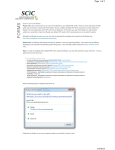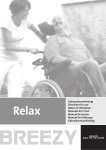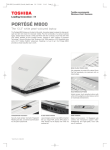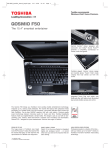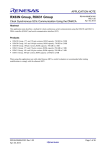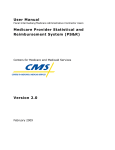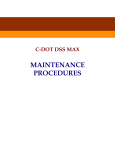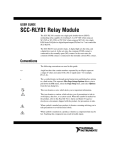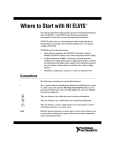Download WHEELCHAIR MAINTENANCE ADVICE SHEETS
Transcript
WHEELCHAIR MAINTENANCE ADVICE SHEETS Regularly servicing your wheelchair will prevent untimely and inconvenient breakdowns, keep repair costs down and extend the wheelchairs life. Below is a list of common problems and checks that should be carried out with actions required to ensure optimal performance from your wheelchair. Please note that whilst many maintenance tasks can be carried out at home it is recommended that your wheelchair is serviced at least once a year by your Wheelchair Service’s approved repairer. For specific advice on your own wheelchair please refer to the User Manual issued with it. However, if you are in any doubt about the functioning of your wheelchair contact your Wheelchair Service approved repairer immediately. TYRES CHECKS WHAT TO DO Pneumatic (air) tyres require monitoring to ensure they are optimally inflated. Under inflated tyres will make pushing the wheelchair harder, stop the brakes from working and increase wear. Monitor monthly for wear and tear. Check for splits, cracks, bulging and loss of tread. Replace tyres when worn. NB: it is better to replace both tyres at once so the wheelchair runs smoothly. Under-inflated tyres. Check tyre pressures once a week using a pressure gauge to compare actual tyre pressure with optimal tyre pressure; as indicated on the side of the tyre. Re-inflate the tyre with a hand pump or electric pump. Make sure the valve is not leaking. Inflate the tyre first then put detergent on the valve to see if it bubbles. Replace tube. Make sure the tube is not leaking. Inflate the tyre first then hold it under water to see if it bubbles. Repair tube. Flat tyres. NB: it is always useful to carry a hand pump in your vehicle or keep one attached to your wheelchair. I:OT:SCIC:WHEELCHAIRPROGRAMME:MAINTENANCE ADVICE SHEET:Aug08 In association with the Institute of Orthopaedics and Musculo-Skeletal Science, University College London WHEEL ALIGNMENT CHECKS WHAT TO DO Overtime and if damaged your wheels can come out of alignment and spokes can become loose causing your wheelchair to veer. Check your wheels weekly to ensure that spokes are intact, rims are not bent and that your wheels are parallel to one another. In an emergency a bike shop may be able to assist in repairing any damage to spokes, wheel rims and/or replacing tyres. AXLES CHECK WHAT TO DO Axles should slide through the axle housing smoothly and “click” into place. No squeaking, catching or excessive side-to-side motion should be present when rolling. Check that the axle housing is free from dirt, hair and mud. Ideally this should be checked weekly. Take the wheels off and wipe the axles with a clean cloth that has a few drops of spray oil on it. Your axles collect dirt easily and need to be kept clean to ensure smooth propelling. CASTORS Ideally contact your Wheelchair Services approved repairer for. Appropriate oils are: AC90 and WD40 or any penetrating lubricants. N.B: Do not use 3:1 oil. Also, try and clean the axle housings and around the bearings, then lubricate with oil. CHECK WHAT TO DO Your castors should run Make sure there is no smoothly, however, they hair, fluff or grit in the are as susceptible to dirt castors. as your axles and need to be looked after in the same manner. Pick out dirt with tweezers or take the spindle out, clean it and then replace it. Make sure that the Lubricate the castor housing castor forks run free and bearings. If it is still not free (one are not bent. continuous turn without it sticking) contact your Wheelchair Service approved repairer for replacement. Make sure the top of the housing is parallel with the floor. Use a spirit level to check the housing is parallel. I:OT:SCIC:WHEELCHAIRPROGRAMME:MAINTENANCE ADVICE SHEET:Aug08 In association with the Institute of Orthopaedics and Musculo-Skeletal Science, University College London BRAKES CHECK WHAT TO DO Brakes can become worn, get damaged or work themselves loose and are then not effective. Apply the brakes and check the tyres are held firmly in place and the brakes are easy to put on/off. Tighten bracket so that brakes are held firmly to the frame in the correct position. N.B: do not over tighten Check the tyres are inflated to the right pressure. Inflate if needed. Check the brakes are complete with all parts correct. Contact Wheelchair Service approved repairer for replacement. Check brakes are not excessively worn. Contact Wheelchair Service approved repairer for replacement. Release brakes and check they do not rub against the tyre when pushing. Reposition brake. NUTS AND BOLTS CHECK WHAT TO DO Nuts and bolts can become loose and can be lost if not tightened. Check that all nuts and bolts are present. Contact Wheelchair Service approved repairer for details of correct grade of missing piece and replace or request their assistance. NB: Only replace nuts and bolts with those of the same grade or strength rating. Make sure that nuts and bolts are secure. Tighten to hand tight or as specified in your wheelchair user manual. Contact your Wheelchair Service approved repairer if unsure. CHECK WHAT TO DO LEGRESTS AND I:OT:SCIC:WHEELCHAIRPROGRAMME:MAINTENANCE ADVICE SHEET:Aug08 In association with the Institute of Orthopaedics and Musculo-Skeletal Science, University College London ARMRESTS If appropriate to your wheelchair, all leg-rests and armrests should be easily removed/swungaway and replaced/repositioned easily. Make sure that parts lock in place securely. If parts are not locking try lubricating. If this is unsuccessful contact your Wheelchair Service approved repairer. WHEELCHAIR FRAME CHECK WHAT TO DO If your frame is damaged your safety is at risk. Check for cracks, splits, large dents and that all moving parts run smoothly. If you find any of these things DO NOT USE. Contact your Wheelchair Service approved repairer immediately. I:OT:SCIC:WHEELCHAIRPROGRAMME:MAINTENANCE ADVICE SHEET:Aug08 In association with the Institute of Orthopaedics and Musculo-Skeletal Science, University College London




